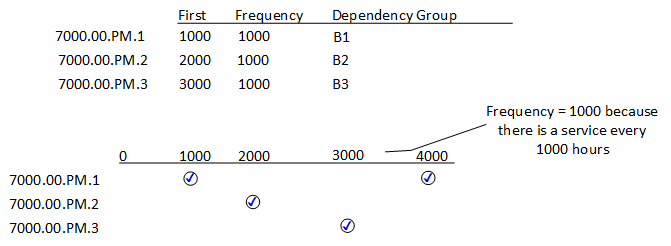Scheduling - Dependency
If you have tasks which are always executed in a sequence, (for example, preventive maintenance service #1 followed by preventive maintenance service #2 followed by preventive maintenance service #3 and then start again at #1), dependency logic is appropriate.
Dependency is where tasks follow each other in a sequence where the lowest number is scheduled to occur first, followed by the second lowest. Once the cycle is complete, then this restarts from the lowest number.
The frequency parameter of the strategy task should be set to the interval after the performance of the preceding task.

In the above example, there are three preventive maintenance tasks which occur starting at 1000 hours, 2000 hours and 3000 hours. Each has been set up in the Dependency grouping “B” and the first task to be executed in the sequence is B1 (because it has the sequence number 1) followed by B2 and B3.
Once the initial round as been completed, that is, after B3 (the last in the sequence) is executed, AMT goes back to B1 and starts again, determined using the Frequency parameters.
AMT still requires a work order to be linked to the strategy task which was executed otherwise the strategy task will be overdue and AMT will not forecast the next occurrence (regardless of its scheduling logic).